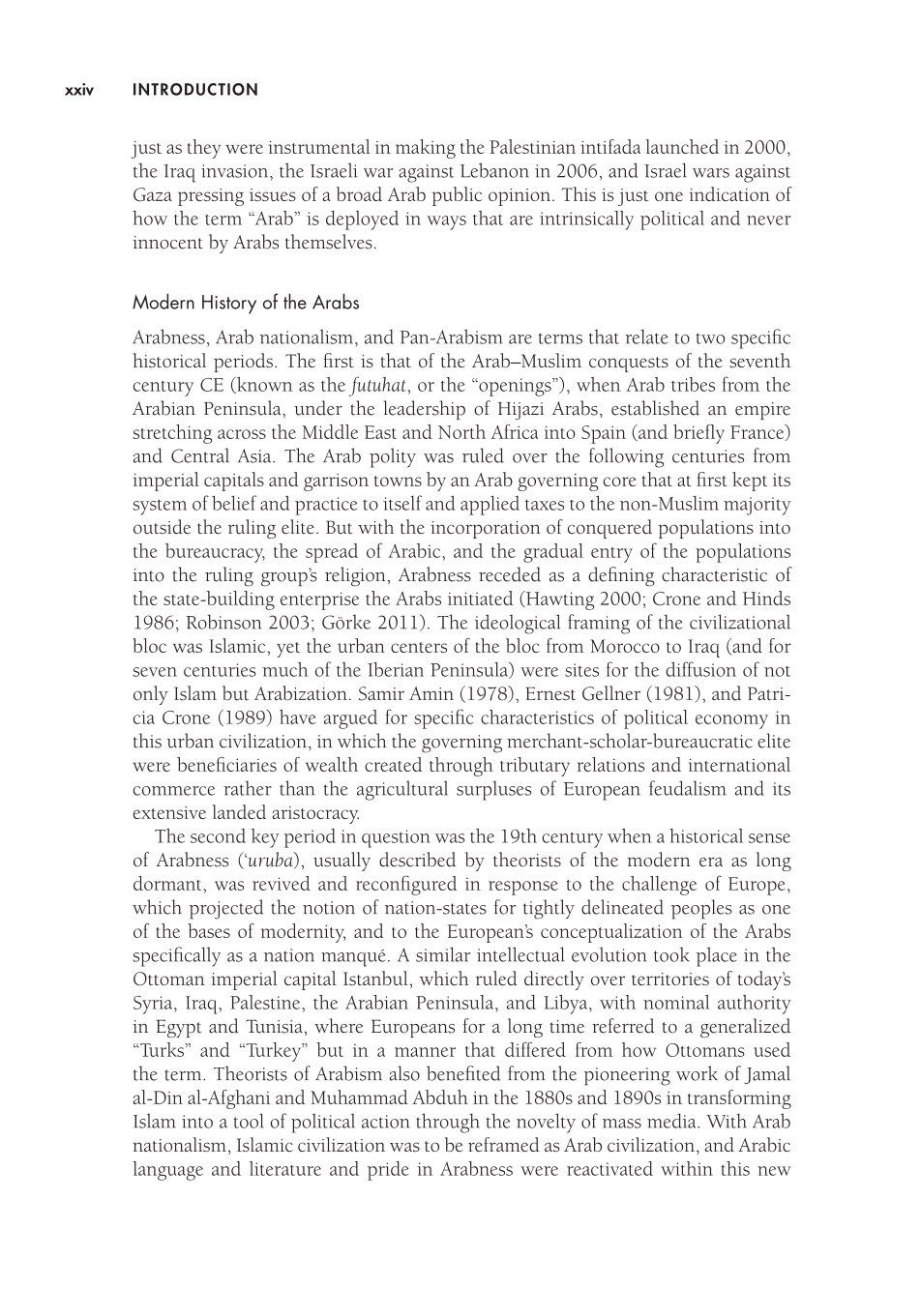xxiv IntroduCtIon
just as they were instrumental in making the Palestinian intifada launched in 2000,
the Iraq invasion, the Israeli war against Lebanon in 2006, and Israel wars against
Gaza pressing issues of a broad Arab public opinion. This is just one indication of
how the term “Arab” is deployed in ways that are intrinsically political and never
innocent by Arabs themselves.
Modern History of the Arabs
Arabness, Arab nationalism, and Pan-Arabism are terms that relate to two specific
historical periods. The first is that of the Arab–Muslim conquests of the seventh
century CE (known as the futuhat, or the “openings”), when Arab tribes from the
Arabian Peninsula, under the leadership of Hijazi Arabs, established an empire
stretching across the Middle East and North Africa into Spain (and briefly France)
and Central Asia. The Arab polity was ruled over the following centuries from
imperial capitals and garrison towns by an Arab governing core that at first kept its
system of belief and practice to itself and applied taxes to the non-Muslim majority
outside the ruling elite. But with the incorporation of conquered populations into
the bureaucracy, the spread of Arabic, and the gradual entry of the populations
into the ruling group’s religion, Arabness receded as a defining characteristic of
the state-building enterprise the Arabs initiated (Hawting 2000; Crone and Hinds
1986; Robinson 2003; Görke 2011). The ideological framing of the civilizational
bloc was Islamic, yet the urban centers of the bloc from Morocco to Iraq (and for
seven centuries much of the Iberian Peninsula) were sites for the diffusion of not
only Islam but Arabization. Samir Amin (1978), Ernest Gellner (1981), and Patri-
cia Crone (1989) have argued for specific characteristics of political economy in
this urban civilization, in which the governing merchant-scholar-bureaucratic elite
were beneficiaries of wealth created through tributary relations and international
commerce rather than the agricultural surpluses of European feudalism and its
extensive landed aristocracy.
The second key period in question was the 19th century when a historical sense
of Arabness (‘uruba), usually described by theorists of the modern era as long
dormant, was revived and reconfigured in response to the challenge of Europe,
which projected the notion of nation-states for tightly delineated peoples as one
of the bases of modernity, and to the European’s conceptualization of the Arabs
specifically as a nation manqué. A similar intellectual evolution took place in the
Ottoman imperial capital Istanbul, which ruled directly over territories of today’s
Syria, Iraq, Palestine, the Arabian Peninsula, and Libya, with nominal authority
in Egypt and Tunisia, where Europeans for a long time referred to a generalized
“Turks” and “Turkey” but in a manner that differed from how Ottomans used
the term. Theorists of Arabism also benefited from the pioneering work of Jamal
al-Din al- Afghani and Muhammad Abduh in the 1880s and 1890s in transforming
Islam into a tool of political action through the novelty of mass media. With Arab
nationalism, Islamic civilization was to be reframed as Arab civilization, and Arabic
language and literature and pride in Arabness were reactivated within this new












































































































































































































































































































































































